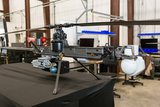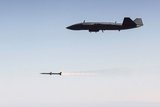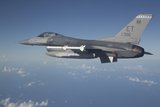B-52H re-engining costs rise by 9%
B-52H Stratofortress seen from a KC-10 Extender. (Photo: USAF/Louis Briscese)
The B-52 Commercial Re-Engining Program (CERP) for the USAF will cost more than anticipated, Acting Air Force Secretary John P Roth admitted on 17 June.
Speaking before the Senate Armed Services Committee, Roth said that CERP costs for the 76-strong B-52H Stratofortress fleet have risen by 9% to about $11 billion, although he denied recent media reports of a 50% increase.
Roth attributed the 9% jump to information obtained from virtual prototyping of the system, certain ‘realities of buying from the current industrial base’ plus ‘a reassessment of the requirement’ and costs associated with the complexity of integrating a modern engine into the ageing B-52H, which entered service in the early 1960s.
USAF Global Strike Command told Shephard in April that it ‘is still evaluating proposals from industry for the B-52 Commercial Engine Replacement Program and is continuing to evaluate industry’s offerings’.
CERP contenders include GE with its CF34 and Passport engines, Rolls-Royce with the F130 and Pratt & Whitney (P&W) with the PW800.
The decision on CERP will probably not happen until late in Q3 or Q4 this year.
Related Equipment in Defence Insight
More from Air Warfare
-
![Anduril UK and GKN Aerospace collaborate on British Army ACP bid]()
Anduril UK and GKN Aerospace collaborate on British Army ACP bid
The pair will submit their demonstrator concept for Project Nyx, a development project for the British Army’s Land Autonomous Collaborative Platform.
-
![US Army command’s Picatinny CLIK common lethal drone interface makes progress]()
US Army command’s Picatinny CLIK common lethal drone interface makes progress
The Picatinny Common Lethality Integration Kit is designed to overcome the issue of unique integration methods between lethal payloads and drones as well as avoiding problematic acquisition conditions created by vendor lock.
-
![Australia invests extra A$1.4 billion in MQ-28A Ghost Bat after successful missile fire test]()
Australia invests extra A$1.4 billion in MQ-28A Ghost Bat after successful missile fire test
The investment includes new contracts for six MQ-28A Ghost Bat aircraft, as well as provisional funds to invest in the development of a Block 3 prototype.
-
![US approves potential $4.7 billion missile and air defence system sales to Denmark and Italy]()
US approves potential $4.7 billion missile and air defence system sales to Denmark and Italy
Italy could field the JASSM-ER for its combat aircraft including the F-35, while Denmark has been approved for AMRAAM and an Integrated Battle Command system procurement.
-
![Northrop Grumman to fly new Project Talon CCA by late 2026]()
Northrop Grumman to fly new Project Talon CCA by late 2026
The newly unveiled collaborative combat aircraft looks to strike a balance between capability and cost-effectiveness, according to the company.























